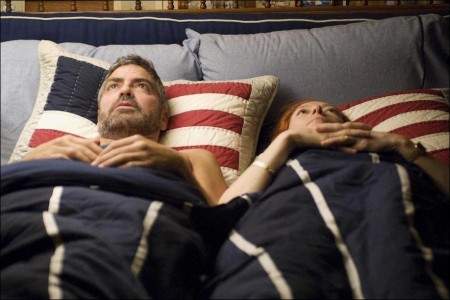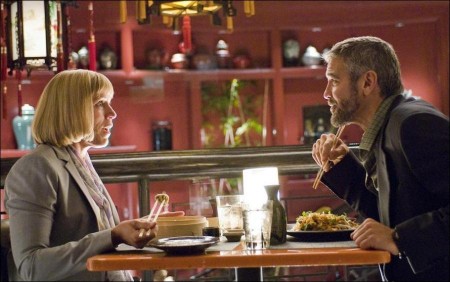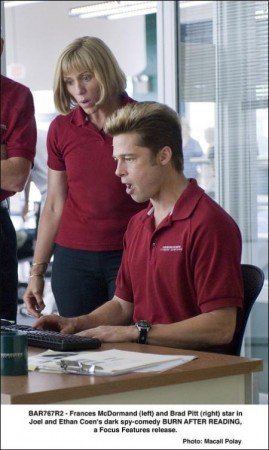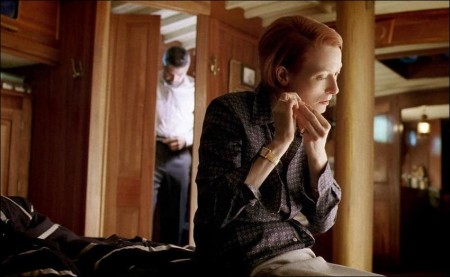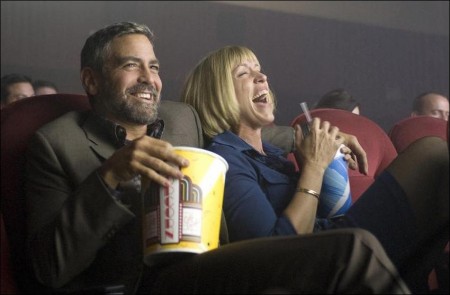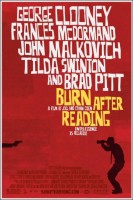Tagline: Intelligence is relative.
At the headquarters of the Central Intelligence Agency in Arlington, analyst Osborne Cox (John Malkovich) arrives for a top-secret meeting. Unfortunately for Cox, the secret is soon out: he is being ousted. Cox does not take the news particularly well and returns to his Georgetown home to work on his memoirs and his drinking, not necessarily in that order. His wife Katie (Tilda Swinton) is dismayed, though not particularly surprised; she is already well into an illicit affair with Harry Pfarrer (George Clooney), a married federal marshal, and sets about making plans to leave Cox for Harry.
Elsewhere in the Washington, D.C. suburbs, and seemingly worlds apart, Hardbodies Fitness Centers employee Linda Litzke (Frances McDormand) can barely concentrate on her work. She is consumed with her life plan for extensive cosmetic surgery, and confides her mission to can-do colleague Chad Feldheimer (Brad Pitt). Linda is all but oblivious to the fact that the gym’s manager Ted Treffon (Richard Jenkins) pines for her even as she arranges dates via the Internet with other men.
When a computer disc containing material for the CIA analyst’s memoirs accidentally falls into the hands of Linda and Chad, the duo are intent on exploiting their find. As Ted frets, “No good can come of this,” events spiral out of everyone’s and anyone’s control, in a cascading series of darkly hilarious encounters.
About The Production
In Burn After Reading, the Coen Brothers mix and match strains of comedic DNA – screwball comedy, satire, sex farce – to weave a tale of an ousted CIA analyst, two D.C. gym employees, and a lost computer disc that may contain highly sensitive material. As events in the contemporary story spin blithely out of control, sinister forces are at work and the dark side of the material comes to the fore.
The fact that Burn After Reading follows last year’s No Country for Old Men in the Coens’ filmography speaks more to timing than to any storytelling avenue being pursued; although the characters in both suffer dire consequences, that has long been a constant in the Brothers’ films.
Joel Coen notes, “We actually wrote this script around the same time we were adapting No Country for Old Men.”
Ethan Coen adds, “We came up with the idea thinking about different parts we wanted to write for actors that we know – who we thought might be fun to throw together; George Clooney, Richard Jenkins, Frances McDormand, and Brad Pitt, each of whom we know and all of whom we have worked with before, except for Brad. We thought about a mix of characters, and a story, that might be interesting to see these actors play.”
Joel enumerates, “Having worked with both George and Richard twice before, and at least four times with Fran, they are among the actors that inspire us to write characters for them.
“Like Brad, John Malkovich is someone we hadn’t worked with before but have wanted to for some time. So we wrote John’s part specifically for him, which was a lot of fun to do.”
The characters in Burn After Reading are, as the Coens clarify, “knuckleheads, but not unlovable ones. We asked the actors to embrace their inner knucklehead.”
Further, says Joel, “The story is about middle-aged people, all of whom are undergoing professional, personal, and sexual crises touching on matters of national security. That’s what makes it a Washington tale. The plot concerns the Central Intelligence Agency and the world of physical fitness, and what happens when those two worlds intersect and collide; Internet dating is also in the mix.”
“It’s a comedy, broadly speaking, and we’ve certainly done those before,” says Ethan. “But the world of Washington, D.C., the world of spies and intrigue – that, we haven’t done before.”
“Well, years and years ago, we did do an adaptation of Advise and Consent in Super 8,” reveals Joel. “That’s the last time we tried taking on `inside the Beltway’ subject matter.”
Ethan admits, “We didn’t get the rights to the original Allen Drury novel, so you can’t see that picture commercially. Like Advise and Consent, this new picture is about the personal meeting the political, with melodrama. Burn After Reading is also our version of a Tony Scott/Jason Bourne kind of movie – without the explosions.”
George Clooney, who has made and/or starred in several politically themed projects, offers, “Despite the Washington setting, this picture is really about shockingly dumb people doing dumb things involving sex and other situations. What makes it even more interesting is that they’re not politicians.
“As soon as they called me up, I knew I’d do it. What could be better? After all, it’s the Coen Brothers. They make roles available to you that people don’t know you’re capable of doing as an actor. Then they told me they wrote the part for me, which worried me…”
Ethan comments, “As George gets older, our characters for George are getting older, and not wiser.”
Clooney muses, “Harry’s not unlike the dopes I’ve played in my other films for the Coens. He’s this sort of sad, moronic character. But there’s a viciousness to this guy that doesn’t exist in, say, Everett in O, Brother Where Art Thou? This script made me howl when I read it. It’s so insane, I just went with it. I grew the beard they thought the character should have and showed up to the set – where I finally had the chance to work with Fran.”
Frances McDormand remembers, “In the first scene for my character in the script, the description said, `Close Up On A Woman’s Ass. Pale. Bare. Middle- Aged.’
“Why should one even read on? Why should one even consider the job?” Ethan reveals, “It’s fun to write for Fran because you know she’s good. It’s not fun to show the script to her once it’s written, because she yells at you.”
“You’ve been scripting it for a number of months, and she’ll go, `This is it?’ But we usually work through that,” assures Joel.
McDormand says, “You know, I’ve been working with Joel and Ethan for the last 25 years. Their first movie [Blood Simple] was my first movie. I don’t know why they make me do what they make me do. But it’s always worth it.”
Brad Pitt had been waiting a long time for a role in a Coen Brothers film, and at last the call came. The actor admits, “I didn’t think the guy would be a dumbbell, a gum-chewing, Gatorade-swilling, iPod-addicted bubble-brain. I said to Joel and Ethan, `He’s such an idiot…’ But, he does have a good heart. “Basically, I see the role as a career-buster.”
Clooney shrugs this off, saying of his longtime friend and costar, “Brad is going to steal Burn After Reading.”
Joel offers, “Brad grew to love playing a numbskull as much as George does, and he’s very funny in the role.”
McDormand adds, “Brad was doing some things in our scenes together which made it very hard not for me to crack up.”
Like Pitt, John Malkovich had been hoping to work with the Coens for years. He states, “When they called and told me they’d written a role for me, well, I was delighted. The whole script centers on people’s quests to change themselves. “Ozzie is a sarcastic man, and an unbelievable lush. When he gets canned, it throws him into a tizzy, and he writes his memoirs – very badly.”
As Cox’s wife Katie, Tilda Swinton reports, “I have great lines, like `Stop the foolishness!’ Katie feels she’s surrounded by bungling fools; she’s angry about everything, disappointed in her husband and disappointed in life.”
Becoming nearly as disappointed is Richard Jenkins’ Ted Treffon, who, the actor says, “is described as `soulful.’ He’s desperately in love with Frances’ character, Linda. But she only thinks of him as a friend.
“I had previously made two other movies with Frances – neither of which we had any scenes together in. I finally got to actually work with her, and she’s as good as you think she is.”
To make Burn After Reading with these specific actors, scheduling became a key issue – another reason why No Country for Old Men went before the cameras first. “Everything was contingent on the availability of this cast,” says Joel. “We found that sweet spot in terms of their calendars, so that dictated when we would shoot,” says Ethan.
When the Coens signed a two-picture pact with Focus Features and Working Title Films, Burn After Reading was designated as the first of the two movies. Working Title and its co-chairs Tim Bevan and Eric Fellner have had a long-term association with the Coens; Fargo (which won Oscars for McDormand as Best Actress and for the Coens in the Original Screenplay category), The Hudsucker Proxy, The Big Lebowski, O Brother, Where Art Thou? (for which Clooney won a Golden Globe Award), and The Man Who Wasn’t There were all made by the Coens with Working Title.
Focus president of production John Lyons had also previously collaborated with the Coen Brothers extensively, as casting director on Raising Arizona, Miller’s Crossing, Barton Fink, The Hudsucker Proxy, Fargo, and The Big Lebowski. With the ensemble, the production company, and the studio in place, the Coens convened another group of regular collaborators, all of whom had just worked with them on No Country for Old Men: costume designer Mary Zophres, set decorator Nancy Haigh, makeup artist Jean Black, sound mixer Peter Kurland, and script supervisor Tom Johnston.
Joel notes, “These are people who are so good at what they do. They’re up for anything on our movies. We’ve been lucky enough to assemble a team of the best people working in these areas.”
Production designer Jess Gonchor, a more recent addition to the team, was also fresh from No Country for Old Men. The Coens’ longtime composer Carter Burwell was again engaged, while two first-time collaborators came on board; BAFTA Award-nominated hair stylist Lyn Quiyou (Memoirs of a Geisha) and fourtime Academy Award-nominated cinematographer Emmanuel Lubezki (Children of Men).
A decision was made at the outset that, although several exteriors for Burn After Reading would be shot on location in Washington, D.C., where the story takes place, the majority of the action would be filmed in the New York area. One major factor in the decision was that the Coens wanted remain close to home and their families; another was that Clooney was working on another project in and around New York.
Principal photography on Burn After Reading began on location in Manhattan, in a downtown law firm which stood in for the D.C. offices of Katie Cox’s lawyer. The unit soon decamped to Paramus, New Jersey, where all the scenes that transpire at Hardbodies Fitness Center – the workplace of Linda, Chad, and Ted – were filmed. At an abandoned building that had until recently housed a Tower Records, Gonchor and his department – with an fitness-equipment assist from Gym Source – transformed the newly emptied space into a working gym. The makeover was so realistic that several Paramus residents walked in and went up to the reception desk to inquire about membership.
After more than a week “at the gym,” the production traveled to Brooklyn’s Steiner Studios for scenes set inside Linda’s apartment and Washington’s Russian embassy. The next stop was New Rochelle, where both exteriors and interiors of Harry’s Chevy Chase, MD residence were lensed. Scenes were also shot in Mamaroneck, Westchester, for a sequence set at a Chesapeake Bay Yacht Club; in Manhattan, at Club Macanudo, a cigar smokers’ club; in Manhattan’s Riverside Park; and in Riverdale, on the grounds of Bronx Community College, for the exterior / entrance of the Russian embassy.
As part of the combining of the two Russian embassy locations, Gonchor notes, “At Steiner Studios, we created this very distinctive round window, 10 feet in diameter, in the Russian functionary’s office where Linda and Chad are interviewed. It was replicating something we had seen and liked on the buildings at Bronx Community College, where the exteriors were shot.” In and around Brooklyn Heights, a succession of townhouses stood in for the Coxes’ swanky Georgetown residence.
Gonchor elaborates, “We gave several Brooklyn Heights streets a facelift, painted some house-fronts, and framed the windows of these houses with black shutters so that they resembled houses in Georgetown. For my department, this was the hardest part of the shoot.”
“To portray the Coxes’ townhouse, we used one location for several downstairs interiors; another for the front entrance, driveway, and a specially built garden wall exterior; still another to establish the house; and a Steiner soundstage, where the upstairs master bedroom and hallway were constructed and dressed.”
The unit also returned to Steiner to film sequences set at the offices of the CIA, and on Cox’s yacht. Although the cast drew considerable paparazzi attention wherever filming was transpiring, the process went smoothly – as is the norm on a Coens shoot. Jenkins comments, “They give an actor responsibility; they know what they want, but they also want you to bring something to the role.”
“As filmmakers, Joel and Ethan are so prepared; they meticulously plan out, and it’s all to the actors’ benefit,” adds McDormand. “We don’t have to wait for them to make decisions. They not intractable, though. They’re open to improvisation to a certain extent, but improvising is not really the way they tell their stories. Their combined sensibility makes it easier for them to articulate what they want to other people, because they’ve already had that conversation themselves.”
Swinton confirms, “They tend to work out things while they’re writing, so that by the time they get to the shoot, they’re in concert. Burn After Reading, to me, has a classic Coens feel to it.
“The shoot was so seamless and familial; a wonderful place to be, with their rhythm of working. It was beyond easy, except for George and I breaking up during takes.” Swinton and Clooney were already well-acquainted, having previously teamed in Michael Clayton, for which she won an Academy Award. Clooney remarks, “I always try to operate the sets of the films I’m directing the way Ethan and Joel run theirs. Their style is just the easiest. They let you try out some ideas you might have on your own but, invariably, the way they see it is the way it should go because they have a very specific plan. I have yet to see them do any rehearsal on anything.
“I learned from them to put storyboards – the visualizations of the shots – on the `sides,’ which are those script pages that are being filmed on a particular day and are distributed to everyone on-set. Looking at the storyboards is a tremendous help to everyone. I’ve hired their storyboard artist, J. Todd Anderson, on the films I’ve directed.”
The other cast member who has worked as a feature director, Malkovich, states, “First of all, the Coens know how to make movies. Secondly, they are not control freaks. They know what they want in each and every frame of film – how it will shoot, how it will cut together – so they don’t waste time, and everything goes along incredibly quickly.
“They let actors work, but they pay attention and retain an openness. It’s all a boon for an actor. You can really get into your characterization.”
It’s these details of character that inform their films with spirit and style. Clooney remarks, “The Coens always give my character something to feverishly obsess over. On O Brother, it was hair; in Intolerable Cruelty, it was teeth; for Burn After Reading, it’s…well, you’ll see.”
“What’s interesting about this movie is that it is all about middle-aged losers,” says McDormand. “George Clooney and Brad Pitt as losers, that’s novel. “You see tragedies about middle-aged people, and comedies about them as well, but not often this combination. This movie is hilarious, but there is also a sadness to our characters.”
The actress further asserts, “There are a lot of middle-aged people out there who still go to the movies. People will be able to relate to my character and the way she sees the world. She’s set on full reconstructive surgery and finding a man, and she simply can’t think about anything else.”
Clooney says, “The men I’ve played for Ethan and Joel comprise what we call my `trilogy of idiots.’ When we were fitting clothes for the character, I asked Mary Zophres if I could wear a gold chain. With that, everything fell into place. I knew exactly what the guy had to look like. Pants high on his waist, kind of a nerd. “I felt as if I was really out there with this character. It was a bit unnerving. But then when I would see Brad Pitt prancing around in tight Spandex shorts, I knew I was okay.”
Similarly, Malkovich muses, “Ozzie’s pretty foolish, so playing him was a lot of fun – especially the scene where he gets fired. I then get to spend a lot of time screaming at people on the phone and playing incredibly drunk.”
Aside from character and characterization, the look and feel of a film are also crucial concerns to the Coens.
Gonchor notes, ““The Coens will say, `Tell us what you want to do, Jess, and we’ll make suggestions from there.’
“Burn After Reading takes place in today’s Washington, D.C. – with not much flash and color, but lively enough. We went for an essentially natural look, yet a lot of the sets are slightly off-center, like the movie itself. While there’s nothing over-the-top, there are some things that are not exactly right and that are a little twisted.”
By way of example for the latter, Gonchor points to an interior of the Russian embassy, built on a Steiner Studios soundstage. “For one office at the embassy, we built a room with the ceiling at 14 feet. The walls are bare except for an 18- inch framed photograph of Russian president Vladimir Putin that hangs very high up. You have to crane your neck to look at it.”
Ethan comments, “What was productive about collaborating with Jess on this movie was how the real locations we looked at or shot at influenced set designs for soundstage work.”
One key location must remain confidential. “We shot some of the CIA connecting-hallway scenes in a secret location,” says Ethan. “That location informed Jess’ CIA office sets – for those offices that are presumably off these hallways.”
“Inside one of those offices, the curtains are closed,” says Gonchor. “Yet the light seems to have a force all its own as it enters the room through the curtain edges. It’s definitely not normal.”
Zophres faced something else out of the ordinary, as she notes; “When I read one of Joel and Ethan’s scripts, exactly how everything should look is evoked for me – without their saying `he/she has this/that on.’ Being hired by them over and over again, I’m the luckiest costume designer in Hollywood, for sure. But, getting George and Brad to look like ordinary guys…?
“How do you make George Clooney of Hollywood and Italy look like Harry Pfarrer of suburban D.C.? The close-cropped beard George grew, coupled with the gold chain, was key. As for Harry’s `date look,’ we decided to put him in a plaid shirt with a sport coat and trousers, and it worked – it took him down a couple of notches.”
Fair enough, but Clooney had, after all, previously dressed down for his Oscar-winning turn in Syriana. So he was used to such a transformation. What to do for Pitt? The costume designer admits, “Brad had to be turned into a dork. Lyn created a hairdo for Chad in which his hair stood up with a bad blond streak in it. That hairdo accomplished a lot. As for his gym uniform, I don’t think we’ve ever seen Brad in a movie wearing shorts, and for our first fitting he came in looking trim and fit, of course. But the shorts, combined with the crew socks and big white sneakers we gave him, managed to make him look a little goofy.
“Then there’s the suit Chad has to wear when told to by Linda. Even cheap suits look better on Brad, so we created one that was ill-fitting, an `executive cut’ – which means it’s made for a portly man. We added an ugly wooly tie that we made from scratch, and it came together perfectly – that is, he looked pretty bad.”
Zophres had, years earlier, costumed McDormand for a 1949 black-and-white setting in the Coens’ The Man Who Wasn’t There. This time, the garb would be contemporary and in color. She explains, “Like Chad, Linda spends a lot of time in the film in her gym uniform, a distinctive company-logo’d polo shirt with dark pants underneath. Those are like exercise pants, even though she’s not a trainer. Joel and Ethan talked about the gym outfit at length, and it was the two of them who worked out the color of the shirt, and its shade of dark red. “Our approach was, let’s outfit Fran first with the uniform, and that will determine what Brad and Richard – as her colleagues – would also be wearing. As with Brad, though, I feel as if the entry point to Fran’s costume was her hair.”
Joel confirms, “We frequently give actors haircuts that they have to somehow disguise during their time away from the set for the duration of the shoot. “But – like Mary’s costumes – it’s a big element in terms of defining characters in our movies. “
Lyn Quiyou, whom Joel and Ethan praise as “fantastic,” created an individual hairstyle for each of the main characters. Linda’s blonde hairdo was achieved through a wig that Quiyou cut especially for McDormand, inspired by a bit of latter-day Washington; Linda Tripp’s hair – specifically, when it was light blonde and bobbed as part of Tripp’s makeover in the wake of the Monica Lewinsky scandal.
Swinton sported a helmet-like cut to play Katie. Here too, the hair helped a performer get into character. The actress marvels, “Katie has a very rigid hairdo; straight, not a wisp of a curl, and a heart-stopping shade of iron-red, if there is such a natural color – which I doubt. I was reminded of Edna Krabappel’s, from The Simpsons.”
As for the character’s wardrobe, “Katie comes from old money and dresses classically in proper attire, albeit with a bit of bling. She favors Ralph Lauren and Cartier,” says Zophres.
Swinton says, “I like working at the look of a character quite precisely. Mary came to my home in Scotland and we had a great time dressing up.” Zophres adds, “It was nice to see that part of the world – even for a day, and with so much luggage!”
As for Swinton’s on-screen husband, Zophres says that “Osborne is classically American, wearing Brooks Brothers and bowties until he gets fired. To me, he has the most interesting arc in the movie, the decline of a character through his wardrobe; he just really lets himself go.”
The background players were also carefully costumed. After all, Zophres clarifies, “This is a contemporary film, yet we still had to dress people from head to toe because people dress differently in D.C. from the rest of the country – certainly different from New York, where we were shooting. It’s conservative, clothes-wise, probably more so than the rest of the Eastern seaboard. We dressed men in dark blue suits, and women in grays with a lot of pearls. It strongly contributes to the sense of place, since Burn After Reading is set in such specific areas of Washington.”
Gonchor adds, “Mary and I were constantly in touch. She’d say, `I was thinking about Linda wearing this,’ and I’d say, `Good, because I want to paint this color here.’ I’d send her pictures of locations.
“Chivo [Lubezki] spent a lot of time in NYC for pre-production, and we were able to go to places together and figure out where he would need to hide lights, where I would have to put in something architectural, and so on.”
After New York, the unit went to Washington, D.C. for a few days to capture locations that couldn’t be duplicated or re-created; this included a stint filming on the Washington Mall, near the reflecting pool in between the Lincoln Memorial and the Washington Monument, in the vicinity of the World War II Memorial. Scenes were also shot on the Key Bride over the Potomac River, and at the Tidal Basin.
When asked what audiences can look forward to with Burn After Reading, John Malkovich advises, “Expect an entertaining and original view of the world, with a way of looking at things that isn’t straightforward.”
Production notes provided by Focus Features.
Burn After Reading
Starring: George Clooney, John Malkovich, Frances McDormand, Brad Pitt, Tilda Swinton
Directed by: Joel Coen, Ethan Coen
Screenplay by: Joel Coen, Ethan Coen
Release Date: September 12, 2008
MPAA Rating: R for for pervasive language, some sexual content and violence.
Studio: Focus Features
Box Office Totals
Domestic: $60,355,347 (38.9%)
Foreign: $94,900,530 (61.1%)
Total: $155,255,877 (Worldwide)
